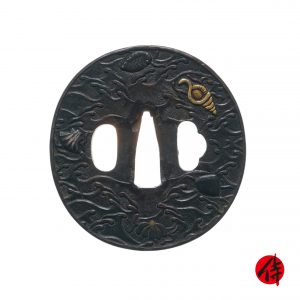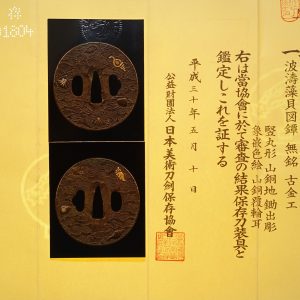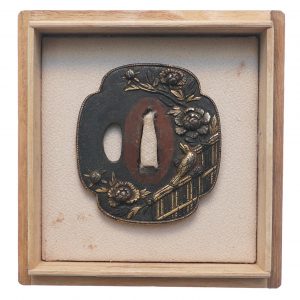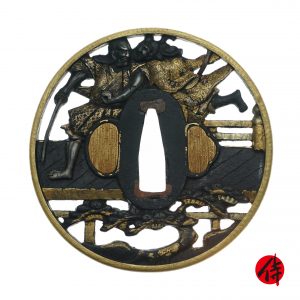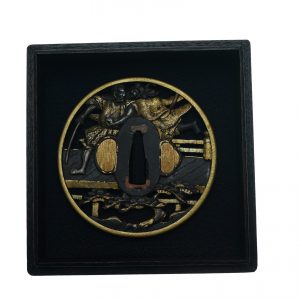Title: Goto-style, Sakin-bukuro
Description
This set of Kougai (ornamental hairpin for samurai) and Kozuka (small utility knife handle) shares a common motif: the Sakin-bukuro (砂金袋, Pouch for Gold Dust).
In Japanese historical dramas, gold in the Edo period (1603–1868) is often depicted in the form of Koban (小判, oval-shaped gold coins). However, in earlier periods, such as the Sengoku era (戦国時代, 1467–1615) and the Kamakura period (1185–1333), gold was more commonly stored as gold dust in pouches rather than coins or bars.
The reason for this lies in the source of gold at the time. Before large-scale gold mines were developed, most gold in Japan was naturally deposited in riverbeds and deltas. This was due to the erosion of gold veins in mountains, which released gold dust and small gold nuggets into rivers. People collected this natural placer gold, which was then stored in pouches for trade and use.
However, this changed in 1601 with the discovery of the Sado Gold Mine (佐渡金山), one of the world’s richest gold deposits. Unlike placer gold, gold in mines is mixed with other minerals and requires extraction. By this time, Japan had adopted the amalgamation process, a technique introduced by European traders, which used mercury to separate gold from ore. The purified gold was then melted and cast into gold bars, which later became the material for Koban coins. As mining production increased, gold bars replaced gold dust as the standard form of gold, leading to the decline of the traditional Sakin-bukuro. This set of sword fittings, featuring the gold dust pouch motif, reflects an era when gold was still carried in its natural form, offering a glimpse into Japan’s historical transition from placer gold to refined gold currency.
Also, these Kougai and Kozuka are made from the Shakudou (赤銅). It has often been used for sword mountings due to its material properties. And it gives an elegant black color for the works as you see in this Kozuka. The surface of this Kozuka is decorated with the Nanako-Ji (魚子地) technique.
This set of Kougai and Kozuka is authenticated by NTHK (NPO Nihon Touken Hozon Kai), the oldest organization for Japanese sword authentication in modern times. According to the certificate, the maker of this Kozuka was identified as Goto Innjo (後藤殷乗). Injo was an accomplished metalworker of the early Edo period, known as the founder of the Goto Shichirouuemon family (後藤七郎右衛門家). He was the third son of Goto Kenjo (後藤顕乗) and was highly skilled in crafting sword fittings. Given his reputation, it is believed that his works were highly esteemed, even in the samurai elite.
*As this item is an antique, please check each photo and ensure its condition.
What is Kozuka?
Kozuka is the small knife stored in Kozuka Hitsu (groove of the sheath of the Japanese sword). Many Tsubas (handguard) have two holes to put Kozuka and Kougai (equipment for appearance) next to Nakagoana (a hole of the Tsuba to put sword), so that Samurai didn’t need to draw his sword out of the scabbard when he wanted to use Kozuka or Kougai. Initially, Samurai used it for cutting wood or attacking enemies in an emergency. It is said that Kozuka was used as a craft knife rather than a weapon.
The decorative designs of Kozuka were more emphasized than its practical use in the Edo period when Samurai society enjoyed one of the most peaceful times. And there were many ornamental Kozuka and Kougai created by Japanese metalworkers.
Why is it that the sword mounting was important for Samurai?
The sword mountings of the Japanese sword have many kinds of decorations such as handguards (Tsuba), sword hilt (Menuki), pommel (Fuchi Kashira). The sword mountings of the Japanese sword have many kinds of decorations such as handguards (Tsuba), sword hilt (Menuki), pommel (Fuchi Kashira). The Japanese sword worked as a weapon and as an object to show who he was. For example, it shows their personalities and beliefs. You could say that it is like decorations for smartphones today. We recommend you zoom in on the pictures of the sword fittings. When you do so, you can see the skill of Japanese metal engraving techniques. They are mainly made of iron and copper with inlays of gold, silver, and bronze. When it comes to handguard (Tsuba), each one has a different outline and weight. These sword fittings that have lived with Japanese swords of the same age might be worth as much as the Japanese swords. They are inconspicuous parts of the Japanese sword. Nevertheless, if you are knowledgeable or particular about it, you will become a connoisseur of the Samurai.



Authentication Paper: NTHK Kanteisho Certificate for the (No. 13058)
NTHK, also known as NPO Nihon Touken Hozon Kai, is the oldest organization for sword authentication of Japanese swords in modern times. It was established in 1889 during the post-Samurai era. They authenticated the kougai and the kozuka on February 16th in the 7th year of Reiwa (2025). The purchaser will receive this original certificate as well. We can also translate what is written into English and make a PDF file for your record if you request.


—————————————————————————————————————
【About us】
Samurai Museum is located in Tokyo, Japan, exhibiting antique artifacts related to the Samurai history. Samurai Museum Shop is the place for those who are interested in Japanese culture and craftsmanship. We deal with antique Samurai swords/armor, traditional crafts made in Japan and so on.
【Payment method】
We accept payment through Stripe (Credit card), PayPal, Apple Pay or ChromePay, all of which are secure payment methods. Also, you don’t need to make an account on Stripe for the checkout. If you prefer other payment method, please contact us. You may either pay in JPY, USD, AUD, CAD, EUR, CHF or GBP. The price is set in Japanese Yen. Prices in other currencies are automatically calculated based on the latest exchange rate.

【Shipping duration】
We normally ship via EMS (Express Mail Service) provided by Japan Post. It usually takes at least 5-14 days to deliver the package after you place an order. Time of delivery is estimated as accurately as possible by the carrier but does not take into account any delays beyond our control such as by inclement weather, post office holiday seasons.
We offer Free International Shipping as long as we can ship your order by EMS. If you prefer other shipping carriers, please contact us.
We will inform you of the order’s tracking number via email. Please make sure you fill out your valid email address correctly.
*Please keep in mind that due to the spread of COVID-19, there might be possible delays in delivery. If you like to make sure if EMS shipping is available to your country, please contact us.

【Antique Japanese Kozuka/Kogai and Export process】
After receiving the full payment from you, we will apply for its export permit from the Board of Education to legally export the Kozuka/Kogai to other countries. It normally takes around 2 to 4 weeks to receive this permit. And we would like you to expect at least 1.0 – 1.5 months for your order to arrive at your given address after you ordered.
【How to make sure the condition】
Please keep in mind that what you are going to purchase is an antique item. We uploaded high resolution photos for you to check its condition thoroughly. If you like to see more photos with different angles, please feel free to contact us. We will be happy to send them to you so that you can make informed decision.
It is essential for us to know that you are happy with your choice of Kozuka and we are prepared to use the best of our ability to serve you.
Would you like see some more Kozuka for sale? Please check the link below. We hope you can find your favorite Kozuka.
https://www.samuraimuseum.jp/shop/product-category/decorations/koduka/





